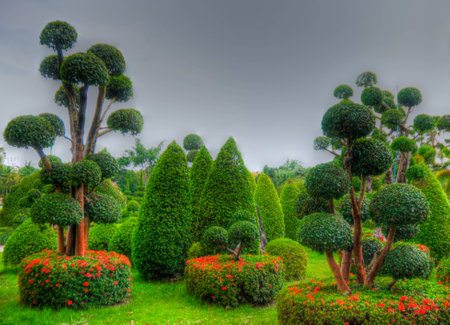Introduction to Garden Design in the UK
Garden design holds a prominent place within British cultural and historical heritage, reflecting centuries of evolving tastes, philosophies, and societal values. The United Kingdom is renowned for its diverse garden styles, ranging from the meticulously structured grounds of grand country estates to the relaxed charm of cottage gardens. This diversity stems from a rich tapestry of influences, including royal patronage, artistic movements, and changing attitudes towards nature and land use. Historically, formal gardens—characterised by geometric layouts, symmetry, and precise planting—were favoured by the aristocracy during the Renaissance and Baroque periods. These designs were intended to demonstrate control over nature and to showcase wealth and power. In contrast, the informal garden emerged as a response to these rigid traditions, gaining popularity in the 18th and 19th centuries. Influenced by Romantic ideals and a growing appreciation for natural beauty, informal gardens embraced flowing lines, organic planting schemes, and an apparent effortlessness that belied careful planning. Today, both formal and informal styles remain integral to British garden design, each offering unique aesthetic experiences while reflecting broader cultural values. Understanding the distinction and evolution between these approaches is essential for appreciating their role in shaping both private gardens and public landscapes across the UK.
Principles of Formal Garden Design
Formal garden design has long been a defining feature of British landscape architecture, especially in the context of stately homes and manor houses. This style is characterised by its emphasis on symmetry, geometric arrangements, and disciplined planting schemes, all of which contribute to a sense of order, refinement, and grandeur.
Core Elements of Formal Gardens
| Design Principle | Description | Typical Features in British Context |
|---|---|---|
| Symmetry | The balanced distribution of garden elements on either side of a central axis to create visual harmony. | Mirrored borders, matching topiary, and paired statuary lining grand pathways. |
| Geometric Layouts | The use of clear shapes such as squares, rectangles, circles, and parterres to define spaces. | Box hedges outlining parterre gardens; gravel or stone paths forming crisp lines around lawns or flowerbeds. |
| Structured Planting | The deliberate arrangement of plants in defined patterns, often using evergreen species for year-round structure. | Rows of clipped yew or boxwood hedges; carefully spaced specimen trees; bedding plants arranged in precise motifs. |
Influences from Stately Homes and Manor Houses
The formal gardens associated with Britain’s grand estates were designed not only to display wealth and taste but also to complement the architecture of the residence. Gardens at places like Hampton Court Palace and Chatsworth House exemplify this approach. Features such as ornamental terraces, fountains, balustraded staircases, and axial vistas extending from the main house reinforce the connection between built form and landscape. These gardens are meticulously maintained to ensure every hedge is sharply trimmed and each border is pristine—a testament to traditional gardening skill.
Summary of Key Characteristics
- Order and discipline: Every element is placed with intent for maximum effect.
- Permanence: Reliance on evergreens and hard landscaping provides year-round structure.
- Cultural heritage: Designs reflect centuries-old traditions rooted in British aristocracy.
This structured approach continues to inspire contemporary garden designers seeking elegance through clarity, balance, and meticulous attention to detail.
![]()
3. Principles of Informal Garden Design
Informal gardens are often celebrated for their naturalistic charm, embodying a relaxed approach that echoes the undulating landscapes of the British countryside. Unlike formal gardens, which rely on symmetry and order, informal gardens prioritise organic forms and a harmonious integration with nature.
Naturalistic Planting
One of the defining characteristics of informal garden design is naturalistic planting. This principle involves arranging plants in a way that mimics how they would grow in the wild, creating soft transitions between different areas of the garden. The aim is to achieve a sense of spontaneity, where perennials, shrubs, and grasses intermingle without rigid boundaries. In Britain, native species such as foxgloves, cow parsley, and bluebells are frequently used to reinforce this authentic countryside feel.
Fluid Lines and Organic Layouts
In contrast to the straight paths and geometric beds typical of formal gardens, informal designs favour fluid lines and gentle curves. Paths meander naturally through the space, guiding visitors on an explorative journey rather than dictating a specific route. Lawns may have wavy edges bordered by mixed borders, creating an inviting sense of movement and discovery throughout the garden.
Integration of Local Flora
The use of local flora is central to informal British gardens. By selecting plants that thrive in local conditions and reflect regional character, gardeners foster biodiversity and resilience. Hedgerows composed of hawthorn or blackthorn, wildflower meadows rich in native blooms, and clusters of woodland species help blur the distinction between cultivated areas and surrounding landscapes. This approach not only supports wildlife but also ensures the garden remains true to its setting.
Reflecting British Countryside Style
The quintessentially relaxed style associated with informal British gardens can be seen in renowned examples like cottage gardens or Capability Brown’s landscape parks. Key features include a seamless blend between cultivated spaces and natural surroundings, with an emphasis on seasonal interest and textural variety. The result is an inviting sanctuary that feels timeless and effortlessly integrated into its environment—hallmarks that continue to inspire contemporary British garden design.
4. Balancing Tradition and Modernity
One of the most compelling challenges in British garden design is achieving harmony between tradition and modernity. Gardens are not only reflections of personal taste but also cultural heritage, making it essential to honour time-honoured principles while embracing contemporary aesthetics and practicalities. This balance ensures that outdoor spaces remain both relevant and meaningful across generations.
Understanding the Value of Heritage
Traditional British gardens—be they stately formal layouts inspired by the likes of Capability Brown or quintessentially informal cottage gardens—are grounded in centuries-old practices. These include structured symmetry, clipped hedges, parterre patterns for formal gardens, and relaxed planting schemes with native species for informal spaces. Incorporating such elements pays homage to Britain’s rich horticultural legacy and preserves a sense of place.
Integrating Contemporary Trends
Modern garden design often prioritises sustainability, multifunctionality, and minimalism. Elements such as eco-friendly materials, wildlife habitats, smart irrigation systems, and flexible social spaces are increasingly prominent in both formal and informal settings. The following table highlights key ways in which tradition can be blended with modernity:
| Traditional Element | Modern Integration |
|---|---|
| Topiary & Formal Hedges | Use native species and drought-tolerant plants for sustainability |
| Cottage Garden Planting | Incorporate pollinator-friendly selections and wildflower meadows |
| Classical Stone Pathways | Employ permeable paving to enhance drainage and reduce runoff |
| Ornamental Water Features | Add solar-powered pumps or rainwater harvesting systems |
Cultural Context Matters
A successful blend respects regional identities—from Cornish subtropical influences to Yorkshire’s rugged stonework. Designers should consider local materials, climate conditions, and historical context when introducing modern features. For instance, using Cotswold stone or recycled bricks ensures authenticity whilst meeting contemporary environmental standards.
Ensuring Longevity and Relevance
The most enduring gardens are those that evolve gracefully, adapting new ideas without sacrificing their roots. By combining the reliability of traditional frameworks with innovative solutions, British gardens continue to inspire while reflecting changing lifestyles. Ultimately, this thoughtful integration safeguards both aesthetic appeal and cultural significance for future generations.
5. Sustainability and Biodiversity in UK Gardens
In recent years, sustainability has become a central tenet in both formal and informal garden design throughout the United Kingdom. As awareness of environmental issues grows, there is a strong emphasis on eco-friendly practices that support local biodiversity while reducing the carbon footprint associated with traditional gardening methods.
Eco-Friendly Practices for Modern Gardens
Gardeners are increasingly adopting techniques such as rainwater harvesting, composting organic waste, and minimising chemical inputs to nurture healthier ecosystems. These methods not only conserve resources but also foster the long-term health of both soil and plant life. Permeable paving, mulching, and careful water management are now seen as essential features, whether designing a structured parterre or a relaxed cottage garden.
Native Planting: A Foundation for Biodiversity
Selecting native species is integral to supporting the UK’s unique flora and fauna. Native plants are better adapted to local conditions, require less maintenance, and provide essential habitats for pollinators like bees, butterflies, and other beneficial insects. In formal gardens, these can be incorporated into borders or specimen plantings; in informal settings, wildflower meadows or hedgerows offer both beauty and ecological value.
Supporting Wildlife through Garden Design
Welcoming wildlife into the garden is a principle that bridges formal elegance with natural abundance. Features such as ponds, bird boxes, log piles, and insect hotels enrich the habitat diversity within both structured landscapes and wilder areas. Thoughtful planting schemes—including berry-producing shrubs and nectar-rich perennials—ensure year-round food sources for birds and pollinators.
Reflecting UK Priorities in Garden Planning
The UK’s increasing focus on sustainability encourages designers and homeowners alike to consider the environmental impact of their gardens from the outset. Whether creating clipped topiary or a naturalistic retreat, integrating sustainable principles ensures that gardens remain resilient, vibrant, and supportive of local wildlife for generations to come.
6. Practical Considerations for British Climates
Designing formal and informal gardens in the UK requires a thoughtful approach to plant selection and material choice, given the nation’s diverse regional climates and characteristic weather patterns. From the temperate, often wet conditions of the south-west to the cooler, windier environments found in Scotland and Northern Ireland, each area presents unique challenges and opportunities for garden design. Successful gardens not only celebrate aesthetic principles but also respond intelligently to their environmental context.
Plant Selection for Regional Suitability
When planning a garden scheme, it is essential to research which plants thrive locally. Hardy perennials such as lupins, foxgloves, and geraniums are well-suited to most British gardens and provide long-lasting structure. In wetter regions, consider moisture-loving species like astilbes or hostas, while coastal areas benefit from salt-tolerant varieties such as sea thrift and escallonia. For formal gardens seeking evergreen structure, traditional choices like box (Buxus sempervirens) or yew (Taxus baccata) remain popular, though alternatives may be advisable due to recent pest challenges.
Adapting Design to Weather Conditions
The unpredictability of British weather demands flexible solutions. Raised beds and well-drained borders help mitigate excess rainfall, protecting roots from waterlogging. Gravel paths and permeable surfaces reduce puddling and ensure year-round accessibility. In exposed sites, strategic placement of hedges or windbreaks can shelter delicate plantings and create microclimates suitable for a wider range of species.
Material Choices for Durability
Materials must be chosen for both their appearance and resilience. Traditional options such as York stone, brick pavers, and local slate harmonise with the British landscape while withstanding frequent rain and frost. Timber structures should be pressure-treated or constructed from durable hardwoods like oak to resist decay. For informal gardens, naturalistic mulches—such as bark or gravel—help retain moisture in dry spells while suppressing weeds.
Sustainable Approaches
Given increasing awareness of sustainability, incorporating native plants supports biodiversity and generally requires less maintenance. Rainwater harvesting systems can be integrated into both formal and informal layouts to irrigate borders efficiently during dry periods. Additionally, selecting locally sourced materials reduces transportation impact and enhances the sense of place within the garden.
By aligning key design principles with practical considerations specific to British climates, gardeners can create spaces that are not only beautiful but resilient—capable of flourishing through the vagaries of the UK’s ever-changing weather.


